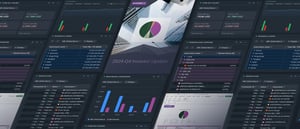
Investment Reporting Software: Features & Benefits with IMS
“Reporting” is a broad term often used to mean many different things in the buy-side industry. There are three dimensions to consider to understand the type of reporting:
Reporting on investment portfolios differs substantially depending on for whom the report is meant. The three primary recipients are:
| Internal stakeholders (to the board, CXOs, compliance, etc) |
| Your investors |
| Regulators, e.g. UCITS, EMIR, MiFiD/MiFIR, AIFMD and/or ARM service providers. |
The vast majority of delivery mechanisms include:
| Files readable by machines (e.g. CSV)* |
| App/web login for humans* |
| Pretty PDFs |
| API access for machines* |
| BI-tool integrations* |
| Excel-plugin* |
* supported in Limina
Lastly, not all portfolio reporting software can report any data. Therefore, it’s essential to validate what data can be reported, including adding custom data. Examples include:
| Performance |
| Risk (exposures, VaR, stress tests, simulations) |
| ESG |
Data collection & aggregation
Before we can create a report, the underlying data needs to be prepared. Preparing data for reporting is not as simple as it sounds (see concrete challenges listed below in this article). At Limina, we strongly recommend selecting an Investment Management System (IMS) with:
- Built-in reporting capabilities (ideally customisable; see more under features in the next section). You might as well report directly from the IMS, because you need all/most data in the IMS anyway. Assuming the IMS has good reporting capabilities (usually not the case). Limina is an IMS with built-in reporting capabilities.
- An IMS with generation-3 (“live extract”) Investment Book Of Record (IBOR) capabilities. This means being able to show portfolios under any assumption. One report might be on the NAV time series, while another might be on adjustments made after NAV is struck. A live-extract IBOR makes creating both of these reports (and many more) simple. To our knowledge, only two vendors offer this, and Limina is one. Book a demo with our technical team to see how it works.
- A user-configurable engine to get data into the software. So you can always import any data you want, e.g., from custodians, GPs, index providers, market data providers, etc.
A video of Limina’s import/export engine:
Features of investment reporting tools (incl. customisation)
Once the data for the report is in order, the investment management reporting software usually consists of two layers:
1. Preparing the data
Pre-processing usually involves transforming the data we want to report on into some kind of table format:
- A flat table or a pivot table
- Grouping functionality on pivot tables includes:
- Any number of layers
- Group on buckets/ranges, for example duration or month
- Transform groupings into columns. For example turn a monthly grouping into columns for January, February, March, etc.
- Bring data in from multiple objects and join it. For example, broker information joined with transactions, to create commissions grouped by broker.
- Calculate custom columns, for example, the average time for an order to get filled per market cap group or how often a fund redemption (on units) is higher/lower than the NAV at notice day.
Limina’s data export engine allows you to do all these operations easily within the user interface, without technical expertise.

2. Format the data
Once data is prepared, the second step is visualisation. The holy grail is the ability to visualise the data in any way and export it to any format.
Examples include:
- Excel-plugin to pull the readily processed data (not just raw data) into spreadsheets that can have prebuilt formatting
- Integrations to Business Intelligence (BI) platforms and data warehouses
- App/web login. Build Dashboard views and share with end clients (read-only client portals)
- Create nicely looking PDFs.
Each area of functionality listed here can have different levels of depth. Just because two vendors check the box doesn’t mean they’re on an equal level of capability. We recommend digging deep into each data format mechanism to understand capabilities and related costs. For example, with some vendors significant professional services costs can apply.
Current investment reporting challenges
Data sources can range from administrators, custodians, general partners, prime brokers, benchmark providers, etc. Data formats aren’t standardised, and data models differ. Most reporting systems approach these challenges with managed connections or complex mapping, which comes at high costs and maintenance headaches. Because connecting data is cumbersome, it leads to only the minimum necessary data sources being connected to the investment reporting system – limiting what you can report on. Limina solves this challenge with a user-configurable import/export engine.
A reporting system is often designed to have one “correct” portfolio view per date/time. However, your portfolios have multiple versions of themselves at any given point in time. For example,
- The investment accounting view includes matched/allocated transactions
- However, the Front Office wants to see portfolios that include simulated orders and preliminary subscriptions.
These are both correct views of the same portfolio, but most systems will only support one. The most common approach systems take is to have one portfolio view at the core and then create other views using adjustments, which never achieves completeness and is prone to errors. Ultimately, the result is that the Front Office team don’t trust what they see. Limina solves this challenge by allowing all components of a portfolio to have a state and trade/settle date:

Beyond representing the current portfolio in multiple ways (see above accordion), knowing what is included and what is not, is equally important. For example, what if there was a settlement issue, is the cash we see taking that into account (or not)? What if we haven’t received data from a provider today, can we see that? Limina solves this with data validations and data quality dashboards.

Multi-layer modelling is often a challenge for portfolio management reporting tools. The most common challenges are:
- Look-through of constituents (e.g. PE-investment systems, mutual funds, index derivatives). Look-through can be possible at both the constituent and proxy levels (e.g., “20% industrials”). Read more about fund of funds software.
- Representing multi-layered ownership structures, such as private investments or a group of family office companies.
Shortcomings of existing portfolio reporting software
In our experience, reporting solutions must fall into one of 2 buckets:
- A “pure” reporting engine, performing no calculations
- If it performs calculations, only doing calculations that aren’t also done elsewhere (e.g. TCA)
If you already have those numbers elsewhere, it makes little sense with a reporting system that performs its own calculations of exposures, P&L, performance, cash, etc. You’d just be adding another source that can be (will be?) inconsistent and need reconciliation and break resolution workflows – costing time and money to maintain.
Now, it matters less if, for example, your investment accounting and reporting software are separate systems or the same. We have two items of recommendation in either case:
- If evaluating a standalone investment reporting software.
Check how easy (or hard) it will be to integrate with your data sources, both other internal systems and external providers. The differences can be substantial (10x+). - If evaluating a reporting system integrated into another system.
Check how to build new reports, is it easy to do yourself? And what if you need to join on new data not in the system with the built-in reporting engine?
Selecting an investment management reporting software
Multiple lists we found online recommend looking at things like robustness of analytics, adhering to new regulation and security. Those are all table stakes; no reputable vendor will fail on these accounts.
Instead, dig deep into the two major functional areas we explored above:
1. Capabilities for preparing data
2. Functionality to format the data
Beyond those, the primary decision you need to make is if you prefer reporting to be standalone and have to deal with calculations in two places and data synchronisation. Or if you’d like reporting to be part of your Investment Management System (e.g. Front-to-back system).
Explore a better investment reporting software
See how Limina can help you increase reporting flexibility and spend less time on reporting.







